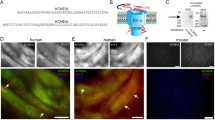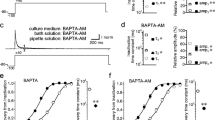Abstract
Recent studies showed that the Ca2+-independent transient outward current (I to) is very small or even not detectable in the porcine left ventricle. We investigated whether an altered molecular expression or function of voltage-dependent potassium channels belonging to the Kv4 sub-family and their ancillary Ca2+-binding β sub-unit KChIP2, which contribute to the major fraction of I to in other species, may underlie this lack of a significant I to in the porcine left ventricle. RT-PCR analysis with degenerate primers showed that both Kv4 mRNA and KChIP2 mRNA are expressed in porcine left ventricular tissue and in isolated ventricular myocytes. PCR cloning and sequence analysis predicted proteins with >98% identity to rat and human Kv4.2 and >99% identity to rat and human KChIP2. Heterologous expression of porcine Kv4.2 in Xenopus laevis oocytes gave rise to currents with characteristic properties of rat and human Kv4.2, and co-expression with its KChIP2 sub-unit increased current density (tenfold), slowed inactivation (twofold) and accelerated recovery from inactivation (tenfold). Kv4.2 immunohistochemistry in porcine left ventricular tissue revealed a predominant membrane-bound signal. Relative quantification of gene expression indicated that Kv4.2 and KChIP2 mRNA and protein are expressed at comparable ratios in porcine and rat left ventricular tissues, which displays a large I to. Collectively, these data demonstrate that the lack of a significant I to in the porcine left ventricle does not result from dysfunctional or insufficiently expressed Kv4.2 and KChIP2 sub-units.








Similar content being viewed by others
References
Schram G, Pourrier M, Melnyk P, Nattel S (2002) Differential distribution of cardiac ion channel expression as a basis for regional specialization in electrical function. Circ Res 90:939–950
Apkon M, Nerbonne JM (1991) Characterization of two distinct depolarization-activated K+ currents in isolated adult rat ventricular myocytes. J Gen Physiol 97:973–1011
Xu H, Guo W, Nerbonne JM (1999) Four kinetically distinct depolarization-activated K+ currents in adult mouse ventricular myocytes. J Gen Physiol 113:661–6d78
Nerbonne JM, Nichols CG, Schwarz TL, Escande D (2001) Genetic manipulation of cardiac K+ channel function in mice: what have we learned, and where do we go from here? Circ Res 89:944–956
Greenstein JL, Wu R, Po S, Tomaselli GF, Winslow RL (2000) Role of the calcium-independent transient outward current I to1 in shaping action potential morphology and duration. Circ Res 87:1026–1033
Lacroix D, Gluais P, Marquié C, D’Hoinne C, Adamantidis M, Bastide M (2002) Repolarization abnormalities and their arrhythmogenic consequences in porcine tachycardia-induced cardiomyopathy. Cardiovasc Res 54:42–50
Näbauer M, Barth A, Kääb S (1997) Repolarization in pig left ventricle: absence of a relevant I to1 and control by I Kr and I Ks. Circulation 96(1):500 (Abstract)
Li GR, Du XL, Siow YL, O K, Tse HF, Lau CP (2003) Calcium-activated transient outward chloride current and phase 1 repolarization of swine ventricular action potential. Cardiovasc Res 58:89–98
An WF, Bowlby MR, Betty M, Cao J, Ling HP, Mendoza G, Hinson JW, Mattsson KI, Strassle BW, Trimmer JS, Rhodes KJ (2000) Modulation of A-type potassium channels by a family of calcium sensors. Nature 403:553–556
Bähring R, Dannenberg J, Peters HC, Leicher T, Pongs O, Isbrandt D (2001) Conserved Kv4 N-terminal domain critical for effects of Kv channel-interacting protein 2.2 on channel expression and gating. J Biol Chem 276:23888–23894
Shibata R, Misonou H, Campomanes CR, Anderson AE, Schrader LA, Doliveira LC, Carroll KI, Sweatt JD, Rhodes KJ, Trimmer JS (2003) A fundamental role for KChIPs in determining the molecular properties and trafficking of Kv4.2 potassium channels. J Biol Chem 278:36445–36454
Volk T, Nguyen TH, Schultz JH and Ehmke H (1999) Relationship between transient outward K+ current and Ca2+ influx in rat cardiac myocytes of endo- and epicardial origin. J Physiol 519:841–850
Chomczynski P, Sacchi N (1987) Single-step method of RNA isolation by acid guanidinium thiocyanate-phenol-chloroform extraction. Anal Biochem 162:156–159
Schultz JH, Volk T, Ehmke H (2001) Heterogeneity of Kv2.1 mRNA expression and delayed rectifier current in single isolated myocytes from rat left ventricle. Circ Res 88:483–490
Hamill OP, Marty A, Neher E, Sakmann B, Sigworth FJ (1981) Improved patch-clamp techniques for high-resolution current recording from cells and cell-free membrane patches. Pflügers Arch 391:85–100
Sheng M, Tsaur ML, Jan YN, Jan LY (1992) Subcellular segregation of two A-type K+ channel proteins in rat central neurons. Neuron 9:271–284
Barry DM, Trimmer JS, Merlie JP, Nerbonne JM (1995) Differential expression of voltage-gated K+ channel subunits in adult rat heart. Relation to functional K+ channels? Circ Res 77:361–369
Livak KJ, Schmittgen TD (2001) Analysis of relative gene expression data using real-time quantitative PCR and the 2-ΔΔCt method. Methods 25:402–408
Clark RB, Bouchard RA, Salinas-Stefanon E, Sanchez-Chapula J, Giles WR (1993) Heterogeneity of action potential waveforms and potassium currents in rat ventricle. Cardiovasc Res 27:1795–1799
Liu DW, Gintant GA and Antzelevitch C.(1993) Ionic bases for electrophysiological distinctions among epicardial, midmyocardial, and endocardial myocytes from the free wall of the canine left ventricle. Circ Res 72:671–687
Wettwer E, Amos GJ, Posival H, Ravens U (1994) Transient outward current in human ventricular myocytes of subepicardial and subendocardial origin. Circ Res 75:473–482
Gómez AM, Bénitah JP, Henzel D, Vinet A, Lorente P, Delgado C (1997) Modulation of electrical heterogeneity by compensated hypertrophy in rat left ventricle. Am J Physiol 272:H1078–H1086
Mukherjee R, Hewett KW, Walker JD, Basler CG, Spinale FG (1998) Changes in L-type calcium channel abundance and function during the transition to pacing-induced congestive heart failure. Cardiovasc Res 37:432–444
Roberds SL, Tamkun MM (1991) Cloning and tissue-specific expression of five voltage-gated potassium channel cDNAs expressed in rat heart. Proc Natl Acad Sci USA 88:1798–1802
Isbrandt D, Leicher T, Waldschütz R, Zhu X, Luhmann U, Michel U, Sauter K, Pongs O (2000) Gene structures and expression profiles of three human KCND (Kv4) potassium channels mediating A-type currents I TO and I SA. Genomics 64:144–154
Litovsky SH, Antzelevitch C (1988) Transient outward current prominent in canine ventricular epicardium but not endocardium. Circ Res 62:116–126
Näbauer M, Beuckelmann DJ, Überfuhr P, Steinbeck G (1996) Regional differences in current density and rate-dependent properties of the transient outward current in subepicardial and subendocardial myocytes of human left ventricle. Circulation 93:168–177
Inoue M, Imanaga I (1993) Masking of A-type K+ channel in guinea pig cardiac cells by extracellular Ca2+. Am J Physiol 264:C1434–C1438
Bailly P, Bénitah JP, Mouchonière M, Vassort G, Lorente P (1997) Regional alteration of the transient outward current in human left ventricular septum during compensated hypertrophy. Circulation 96:1266–1274
Macianskiene R, Moccia F, Sipido KR, Flameng W, Mubagwa K (2002) Channels involved in transient currents unmasked by removal of extracellular calcium in cardiac cells. Am J Physiol Heart Circ Physiol 282:H1879–H1888
Hess P, Lansman JB, Nilius B, Tsien RW (1986) Calcium channel types in cardiac myocytes: modulation by dihydropyridines and beta-adrenergic stimulation. J Cardiovasc Pharmacol 8 (Suppl 9):S11–S21
Matsuda H (1986) Sodium conductance in calcium channels of guinea-pig ventricular cells induced by removal of external calcium ions. Pflügers Arch 407:465–475
Patel SP, Campbell DL, Morales MJ, Strauss HC (2002) Heterogeneous expression of KChIP2 isoforms in the ferret heart. J Physiol 539:649–656
Patel SP, Campbell DL, Strauss HC (2002) Elucidating KChIP effects on Kv4.3 inactivation and recovery kinetics with a minimal KChIP2 isoform. J Physiol 545:5–11
Birnbaum SG, Varga AW, Yuan LL, Anderson AE, Sweatt JD, Schrader LA (2004) Structure and function of Kv4-family transient potassium channels. Physiol Rev 84:803–833
Rosati B, Pan Z, Lypen S, Wang HS, Cohen I, Dixon JE, McKinnon D (2001) Regulation of KChIP2 potassium channel β subunit gene expression underlies the gradient of transient outward current in canine and human ventricle. J Physiol 533:119–125
Rosati B, Grau F, Rodriguez S, Li H, Nerbonne JM, McKinnon D (2003) Concordant expression of KChIP2 mRNA, protein and transient outward current throughout the canine ventricle. J Physiol 548:815–822
Wettwer E, Amos G, Gath J, Zerkowski HR, Reidemeister JC, Ravens U (1993) Transient outward current in human and rat ventricular myocytes. Cardiovasc Res 27:1662–1669
Acknowledgments
We are most grateful to R. Dussel and T. Kock for the technical assistance, and Priv. Doz. Dr. J. Zanzinger for the explantation of the porcine hearts. We gratefully acknowledge the donation of the Kv4.2 primary antibody by Prof. Dr. L.Y. Jan, and the donation of the pan-KChIP antibody by Prof. Dr. O. Pongs and Dr. D. Isbrandt. Supported by the Deutsche Forschungsgemeinschaft grants to H.E. and C.A.H (Graduiertenkolleg “Experimentelle Nieren- und Kreislaufforschung” and FOR 604).
Author information
Authors and Affiliations
Corresponding author
Rights and permissions
About this article
Cite this article
Schultz, JH., Volk, T., Bassalaý, P. et al. Molecular and functional characterization of Kv4.2 and KChIP2 expressed in the porcine left ventricle. Pflugers Arch - Eur J Physiol 454, 195–207 (2007). https://doi.org/10.1007/s00424-006-0203-1
Received:
Accepted:
Published:
Issue Date:
DOI: https://doi.org/10.1007/s00424-006-0203-1




